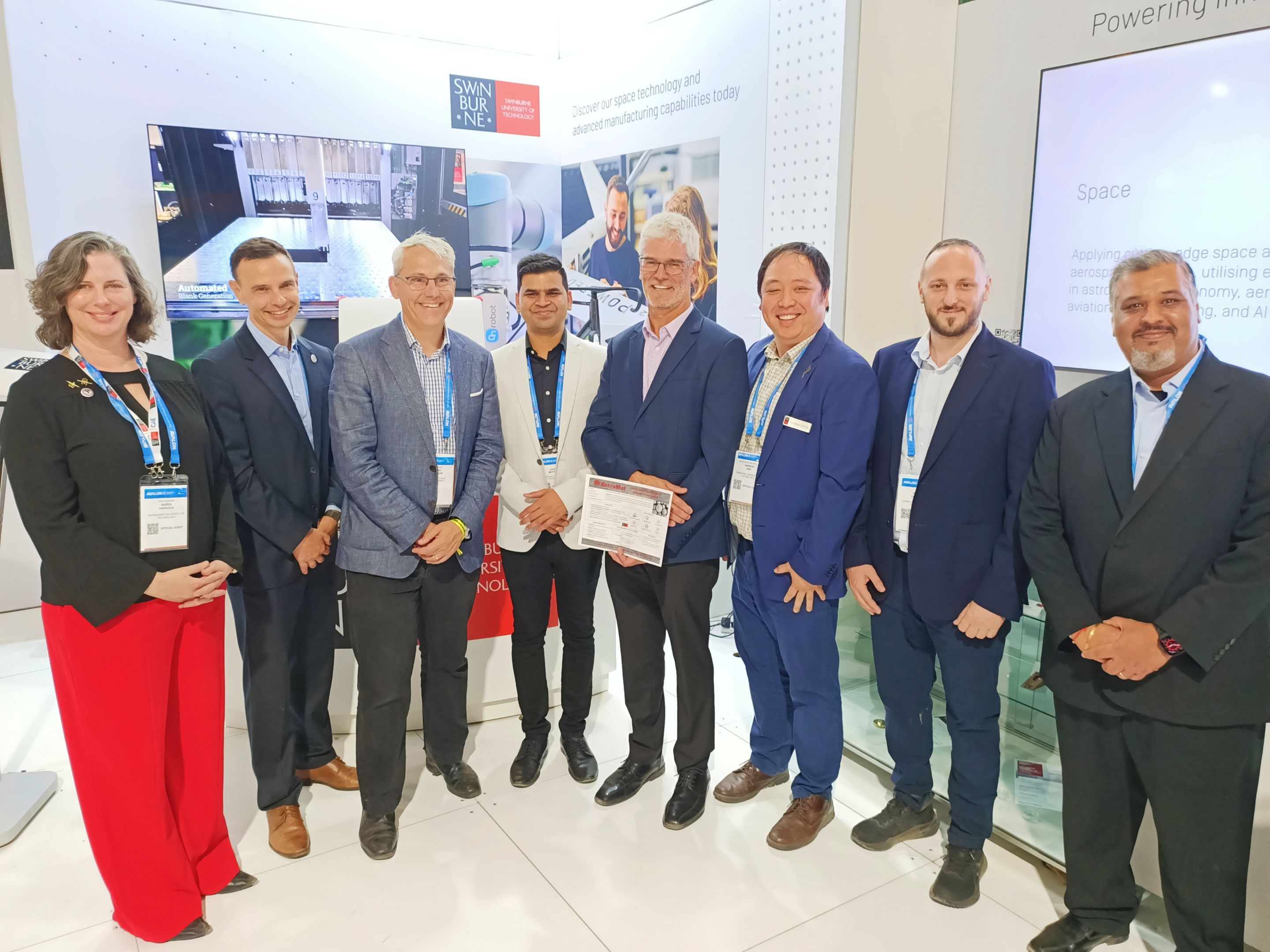Swinburne University of Technology's presence at the Avalon Australian International Airshow 2025 showcased groundbreaking contributions to aerospace, advanced manufacturing, detect and protect research, and space technology.
From March 25-30, the university highlighted a range of state-of-the-art capabilities by Swinburne's Aerostructures Innovation Research (AIR) Hub, the Swinburne-CSIRO National Industry 4.0 Testlab and the Space Technology and Industry Institute , alongside innovative projects, spinouts and collaborations with global industry leaders.
Swinburne's Department of Aviation also partnered with our exclusive aviation training partner CAE to display a Cessna 172 single, a Piper Pa44 Seminole twin and a Beech Kingair 90 turboprop, three of the planes aviation students gain experience on. Swinburne is the first university in Victoria to teach aviation for both management and piloting positions.
Swinburne signs to support Australia's first lunar rover mission
Swinburne's pioneering research into lunar dust mitigation and space radiation technology was on show over the week. By supporting Australia's first lunar rover mission - the $50 million Roo-ver Trailblazer project - Swinburne's involvement will mark a significant milestone in the nation's space exploration efforts.
Representatives from Swinburne, ELO2 and industry came together for a signing ceremony at Avalon Airshow to celebrate their partnership in this ground-breaking project.
The ELO2 rover, named Roo-ver, will be the first designed, manufactured, and tested entirely in Australia. Swinburne's Space Technology and Industry Institute is contributing space radiation and lunar dust mitigation technology for the rover, essential to its successful performance. Swinburne's experts will evaluate and test how the Moon's hazardous radiation and harsh conditions will impact the Roo-ver.
Other space science highlights during Avalon included Swinburne's Virtual Explorer - a simulation of the ELO2 lunar rover for Avalon attendees to test drive - and Dr Rebecca Allen's panel at the Southern Space Conference, which discussed Australia's role in the future of space industrialization as a leader in microgravity research.
.JPG/_jcr_content/renditions/cq5dam.web.3840.2160.jpeg)
Swinburne and the ELO2 Consortium signed a Letter of Intent outlining our contributions to deliver Australia's first lunar rover.
Startup announcement: EntroMat makes sustainable powders to drive advanced manufacturing
Swinburne also announced the launch of EntroMat, the university's first high-tech spinout through Breakthrough Victoria's multi-million dollar University Innovation Platform .
EntroMat will deliver Australian-made high-performance High Entropy Material (HEM) powders to advanced manufacturing and 3D printing facilities, pioneering a unique, circular use of critical minerals.
HEM powders have exceptional properties, like mechanical strength, thermal stability, and resistance to corrosion, wear, and radiation. These qualities make them useful for aerospace, mining, medical technology and more.
The Hon Danny Pearson MP, Victoria's Minister for Economic Growth and Jobs, met with Swinburne's EntroMat founders at Avalon Airshow, discussing innovation in sovereign manufacturing.

Swinburne and Skyportz win Avalon 2025 Innovation Award
Swinburne's collaboration with Skyportz, led by Professor Justin Leontini from the Department of Mechanical and Product Design Engineering , has won the Avalon 2025 Blue-Sky Thinking Innovation Award.
The award recognises the innovative work on a modular vertipad for air taxis, developed by Swinburne's industry partner, Skyportz. Skyportz recently unveiled a modular vertipad patent that aims to reduce turbulence from electric Vertical Take-Off and Landing (eVTOL) aircraft landings.
Swinburne's research suggests the new design could dissipate energy up to 250 per cent faster than a traditional flat tarmac surface, with the potential to reduce the impact of turbulent airflows generated during takeoff and landing.
"If effective, this could enable air taxi operations on smaller sites, expanding the potential for urban vertiports beyond traditional airports and helipads," Professor Leontini said.
Swinburne's initial modelling involved experimenting with different landing surface treatments to improve aerodynamic dissipation, a critical step in enhancing the safety and efficiency of future air taxi services.
Transforming manufacturing with 3D printing and digital integration
Swinburne's trade show stand at Avalon also demonstrated the work of our world-class Swinburne-CSIRO National Industry 4.0 Testlab . The Testlab provides fully digitally-supported engineering and manufacturing solutions for parts, processes and entire systems across diverse industry sectors.
Aerospace is one sector this transformative work is shaping. Dr Adriano Di Pietro, director of Swinburne's AIR Hub, led a session on Manufacturing eVTOL Technology Assessment (META), highlighting the innovative drone wingbox demo developed in our Testlab.
The wingbox offered visitors a demonstration of advanced high-rate manufacturing technology for aerospace-grade thermoplastic composites. It was developed through an automated production process, with a digital twin to simulate and optimise every stage - from cutting to welding and final assembly.
Professor Suresh Palanisamy, Director of Swinburne's Manufacturing Futures Research Platform , spoke to the future of accelerating digital integration and 3D printing in manufacturing. He presented on Swinburne's commitment to the Australian Manufacturing Cooperative Research Centre and introduced the 3D printing and selective laser melting capabilities of Swinburne's Factory of the Future , which help manufacturers replace on-off or small volume parts with ease.
Advancing aerospace with Swinburne's AIR Hub
The expertise of Swinburne's AIR Hub was on display at Avalon. AIR Hub is developing the next generation of aerostructures for use in civil aviation, eVTOL, uncrewed aerial systems, advanced air mobility and space. The team works alongside industry partners on design and prototyping, through to manufacturing complex composite aerostructures.
Dr Adriano Di Pietro, Director of AIR Hub, gave a tech talk on our next-gen hydrogen-powered GHOST drone. GHOST offers zero emissions vertical take-off and landing - using battery power for lift-off, and hydrogen power for forward flight. Its sustainable tech could be used to deliver packages to the regions or carry medical supplies into remote places.
Dr Di Pietro also launched Swinburne's new Introduction to Advanced Air Mobility short course , designed for professionals looking to pivot into a future-focused industry, understand career paths and uncover investment and partnership opportunities.
.jpg/_jcr_content/renditions/cq5dam.web.3840.2160.jpeg)






